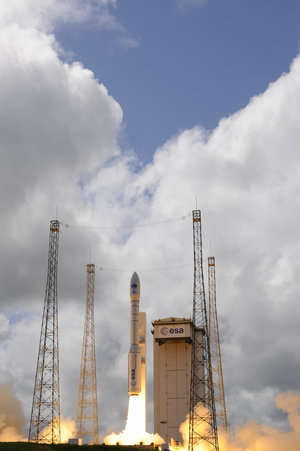ESA celebrates 50 years of ESRIN
ESRIN, ESA’s centre for Earth observation in Frascati, near Rome, is one of the agency’s main specialised centres in Europe, and its founding ceremony took place 50 years ago on 27 September 1968.
Today, ESRIN manages the exploitation phase of the Earth Observation satellites and the ground segment for ESA and third-party Earth observation satellites, maintaining the largest archive of environmental data in Europe and coordinating over 20 ground stations and ground segment facilities in Europe. It also hosts the project team managing the Vega small-launcher programme.
But back in the 1960s, one of the major challenges for the fledgling space organisation ESRO was agreement on where to locate its various facilities. In April 1962, after the European Space Research Laboratory (ESLAB) was setup near ESTEC in the Netherlands, it was decided that another laboratory for advanced research was needed.
By June 1962, the ESLAR laboratory was set up in Italy in addition to ESLAB. It was later renamed ESRIN, the European Space Research Institute. ESRIN would complement the other activities of the organisation by providing a group of experts in specialised fields of theoretical and experimental physics, chemistry and plasma physics, and who would be engaged in original research and keep the space research programme under review. The main laboratory activity was concentrated on experiments to study physical and chemical phenomena in space.
On 29 July 1964, Hermann Jordan was appointed as first Director of ESRIN. Before ESRIN had its own buildings, staff worked temporarily from January 1966 in the Park Hotel, Frascati, loaned by the Archbishop of Frascati.

The ceremony to lay the cornerstone of the new ESRIN buildings took place on 27 September 1968. Ambassadors, scientists, national and local authorities, delegates and journalists were there to follow the addresses by Professor Hendrick C. van de Hulst, Chairman of ESRO Council, Hermann Bondi, ESRO Director General, the Director of ESRIN, Mr Clotaire Wood, the European NASA representative, Prof. Vincenzo Caglioti, Chairman of the Italian National Research Council, Mr Guglielmo Boazelli, Mayor of Frascati, and Prof. Mario Pedini, Undersecretary of State for Scientific Research in Italy.

A blessing was given by the Archbishop of Frascati and a Latin-inscribed scroll was sealed inside the cornerstone. The stone was laid by Prof. Pedini, as the official representative of the Italian government. The stone also contained the symbolic ten coins of ESRO Member States. The ceremony was transmitted the same day on Italian national television.
On the 18 March 1970, when the ‘topping-out’ ceremony took place (the celebration normally held when the structure of a building has the roof added), a new Director was in place, Dr Nicola D’Angelo.
The new orientations of ESRO between 1971 and 1973, together with the decisions taken by the European Space Conference, had a severe impact on the role of ESRIN. The space physics laboratory was closed and the establishment took on other tasks, namely the Space Documentation Service and the development of the Information Retrieval Service database in the next decade.

A second orientation in the 1990s, with the need to manage the large amounts of Earth observation data of ERS-1, ERS-2 and Envisat, again changed the configuration of ESRIN, which is now the main ESA centre for Earth observation where all the missions of Earth Explorer and Copernicus programmes are managed, as well as ESA information technology and other corporate activities.
ESRIN began hosting the integrated project team managing the Vega small launcher development programme in 1999. The team included staff from ESA, ASI and CNES. Its presence introduced a completely new set of expertise and activities in ESRIN, including specialist project reviews and regular progress meetings with European industry.
In 2013, the Near-Earth Object (NEO) Coordination Centre was inaugurated at ESRIN, to serve as the central access point to a network of European NEO data sources and information providers being established under ESA’s Space Situational Awareness Programme.
The 50-year celebrations of ESA sites around Europe began in 2017 with the European Space Operations Centre (ESOC) in Germany and continued this year also with ESEC (formerly Redu) in Belgium. These milestone anniversaries offer an opportunity to highlight Europe as a strong global actor in the space sector, and reflect the knowledge, experience and capabilities of ESA as we prepare for the challenges of the next decade in space and beyond.
References
ESRO ELDO Bulletin, No. 3, November 1968, « L’Institut Européen de Recherche Spatiale » by H.L. Jordan, Director of ESRIN, pp. 11-19 (also pp. 43-44 for the official inauguration)
ESRO ELDO Bulletin No. 9, April 1970 - Page 28









